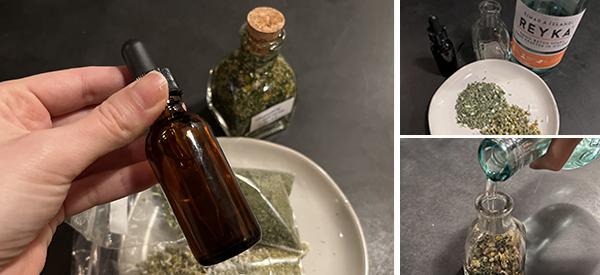
How to Make a First-Aid Tincture
With cuts, stings, tummy aches, and bug bites being so prevalent in daily life, assembling an herbal first-aid kit is a no-brainer.
There are herbs that can treat all of these ailments and many more. Also, tinctures, oils, and poultices are so easy to make.
First-Aid Tincture Herbs
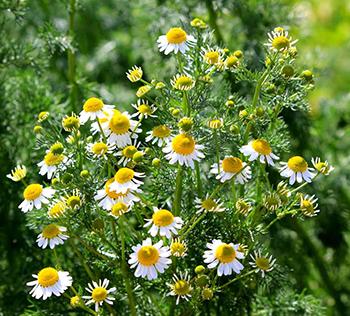 Chamomile (Matricaria recutita) and Echinacea (Echinacea purpurea) are the herbalist’s staples. These herbs have been used for centuries in traditional medicine for their soothing and healing properties. Both have been shown to have numerous simultaneous health benefits, making them a natural choice for use in a first-aid tincture.
Chamomile (Matricaria recutita) and Echinacea (Echinacea purpurea) are the herbalist’s staples. These herbs have been used for centuries in traditional medicine for their soothing and healing properties. Both have been shown to have numerous simultaneous health benefits, making them a natural choice for use in a first-aid tincture.
Chamomile is a popular herb that has been used around the world to treat a variety of ailments. It is most commonly known for its calming effects and is often used to help with sleep, anxiety, and stress.
Chamomile is also anti-inflammatory and can be used to soothe minor cuts, scrapes, and bruises. It has been shown to be effective in reducing redness and swelling and can help to speed up the healing process of injured tissues.
Taken internally, it can help soothe an upset stomach and heartburn.
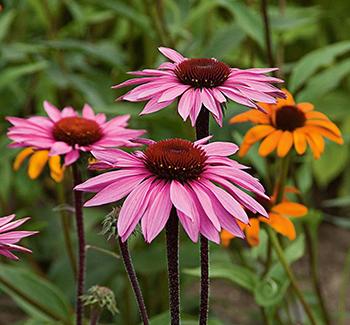 Echinacea is another herb that has a long history of use in traditional medicine. It is known for its immune-boosting properties and is often taken to help prevent or reduce the severity of colds and flu.
Echinacea is another herb that has a long history of use in traditional medicine. It is known for its immune-boosting properties and is often taken to help prevent or reduce the severity of colds and flu.
Researchers found that taking echinacea cuts the chances of catching a cold by 58%, and if you do get sick, echinacea can reduce the average duration of sickness by almost a day and a half.
Like chamomile, echinacea is also anti-inflammatory and can be used to soothe minor cuts, scrapes, and bruises. Studies have demonstrated that it can effectively reduce pain and accelerate the healing process
Together, chamomile and echinacea make a powerful combination for use in a first-aid tincture. A tincture like that can be used to treat external issues like cuts and insect bites, as well as internal issues like colds, indigestion, and anxiety.
They are both hardy plants making them incredibly easy to grow in your herb garden. And if you don’t have a garden, they are easy to source – any health or herbal shop is sure to carry them. Whether you’re dealing with a minor cut or scrape, or just looking for a natural way to boost your overall health and well-being, a first-aid tincture made with chamomile and echinacea is a great choice.
How To Use The First-Aid Tincture
Herbal tinctures are liquid extracts of herbs that are made by soaking the plant material in alcohol or vinegar for 4-6 weeks. They are a concentrated form of herbal medicine that can be taken internally or used topically.
Internally, herbal tinctures can be taken by themselves or mixed into drinks or food. They are often taken in small doses – a few drops at a time – as they can be pretty potent.
Take this tincture internally to treat anxiety, colds and flu, and any ailments of the digestive tract.
Topically, this first-aid tincture can be applied directly to the skin, added to a salve, or mixed with water and used as a topical compress to treat skin conditions such as acne, eczema, and wounds.
⇒ Stitching a Wound When Asking for Help Is Not an Option (Video)
Overall, this herbal tincture is one of the most versatile instruments in your first-aid kit. Simple to make, it’s potent and compact and lasts years without going bad.
DIY First Aid Herbal Tincture Recipe
Our first-aid tincture is quick and easy to make, although you will need to give it time to steep for at least 4 weeks.
Follow these steps to get your tincture ready:
You will need:
- a glass jar with a tight-fitting lid or cork
- fresh or dried herbs
- high-proof alcohol such as vodka or rum. You can also use vinegar or vegetable glycerin as the solvent, but alcohol will extract more of the herb’s medicinal compounds.
 When it comes to the herbs, for this tincture, I recommend using:
When it comes to the herbs, for this tincture, I recommend using:
- German Chamomile (Matricaria recutita)
- Echinacea (Echinacea purpurea)
As an alternative to German chamomile, you can use Roman chamomile (Chamaemelum nobile) as both types share similar properties.
For the Echinacea, I like using the tops (flowers and leaves) because I save the roots for another herbal tincture that specifically targets hypertension. You are welcome to use roots in this tincture as well, as long as you’re also using the tops to maximize the plant’s healing benefits.
Steps:
1. Prepare the herbs. If using fresh herbs, wash and chop them finely. If using dried herbs, crumble them to a fine consistency. I used about a half cup of dry herbs total and mixed them at a 50:50 ratio.
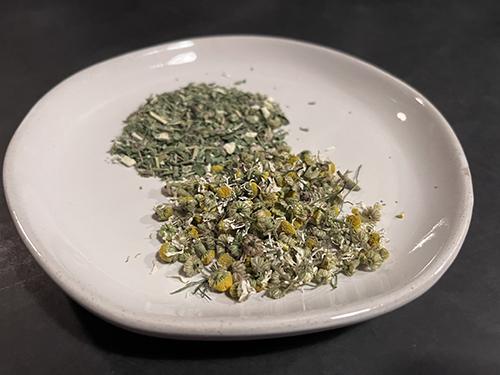
2. Fill the jar. Pack the herbs into the jar as tightly as possible. Depending on the size of the jar you’re using, you might need more herbs. Aim to fill the jar with tightly-packed plant matter about halfway up.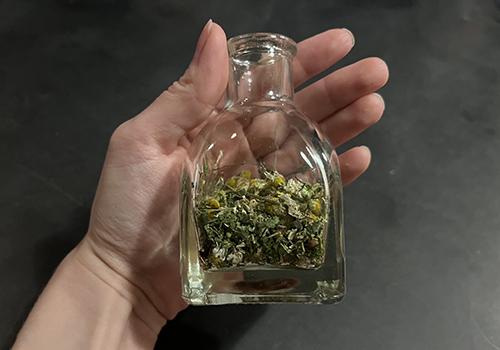
3. Add the alcohol. Pour the alcohol over the herbs until the jar is full, making sure to completely cover the herbs. Seal your jar and shake up the contents to make sure that everything is mixed well.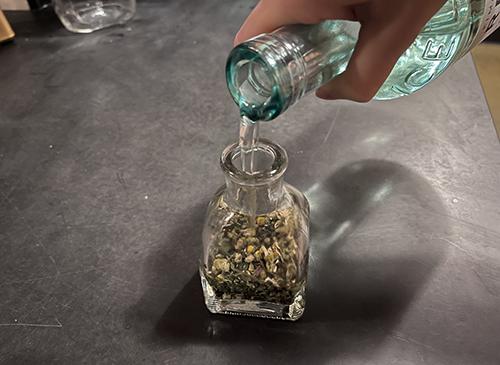
4. Label, label, label. If you’ve ever made tinctures before, you know how important it is to label your jars! There’s nothing worse than going into your cupboard weeks later and trying to remember which tincture is which, especially if you make several at a time.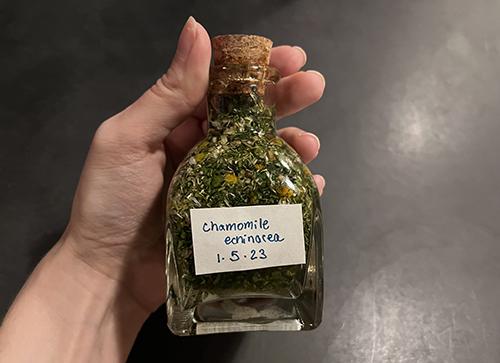
These herbs can start to look very similar after soaking in alcohol for some time. Secure the lid tightly and label the jar with the name of the herbs and the date that you started it. I don’t use anything fancy for my labels – just a piece of paper taped to the jar.
5. Steep the tincture. Store the jar in a cool, dark place and allow it to steep for at least 4 weeks, shaking the jar regularly. If using alcohol, the tincture will be ready to strain in 4 weeks. That being said, I like to let my tinctures steep a little longer – about 6 weeks if time allows. This makes them a little bit more potent so a little bit goes a long way.
6. Strain the tincture. When the tincture is ready, strain it through a cheesecloth or fine-mesh sieve to remove the plant material.
7. Bottle the tincture. Transfer the tincture to a clean, dark glass bottle with a dropper. I suggest using a funnel if your bottle has a small opening. You don’t want to spill any of this goodness!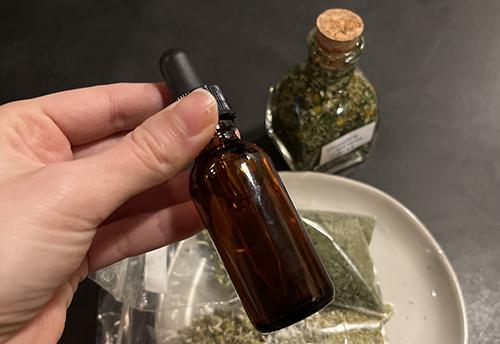
If you don’t have a bottle with a dropper, any dark glass bottle will do. But the dropper makes it a lot easier to measure out the right doses (more on that later).
8. Store the tincture. Keep the tincture in a cool, dark place. I suggest creating a “first-aid” cubby that you can keep in a dry pantry or cupboard.
Stored properly, this tincture is good for 2-3 years. The alcohol in it will prevent any bacterial growth.
Dosage
When it comes to using herbal tinctures, dosage is an important factor to consider. Taking too much of a tincture can lead to unwanted side effects, while taking too little may not produce the desired therapeutic effect. In general, it is best to start with a lower dosage and gradually increase it as needed.
Most herbalists recommend no more than 25-30 drops three times a day for tinctures containing echinacea and chamomile. This is about one full dropper.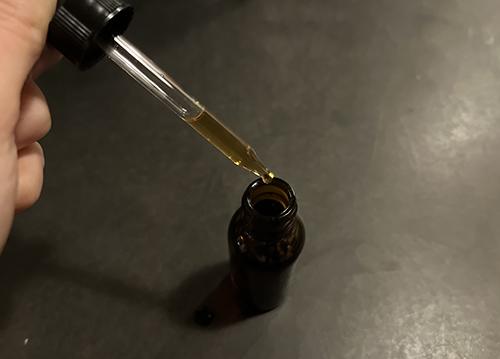
When giving the tincture to children, use caution and start slowly to gauge their response. Children have less body weight and may get the benefits of the tincture with a smaller dose.
Some herbalists have a formula they use for calculating dosage per body weight. This formula recommends 1 drop for every 2 lbs. of body weight.
If you’re ever in doubt about safely using your first-aid tincture, ask a qualified herbalist for their advice!
The Bottom Line
Don’t wait until it’s too late to make your first-aid herbal tincture. Echinacea and chamomile are absolute superstars when it comes to treating a variety of conditions. You’ll always be able to find a use for this simple yet powerful tincture.
Don’t be afraid to experiment, either. You can always add other herbs to the mix to add even more medicinal benefits. For example, Yarrow is another versatile plant that you can add to your first-aid tincture. It helps stop bleeding when applied to an open wound and improves digestion when taken internally.
At the end of the day, there are lots of great herbs that can be used in your first-aid kit. Echinacea and Chamomile are the most common, but you are always welcome to customize your tincture to suit your needs!
You may also like:
 DIY Anti-Viral Pine Needle Tincture
DIY Anti-Viral Pine Needle Tincture
How to Build A Cheap Bunker in Your Backyard (Video)
Elderberry Syrup With Echinacea and Goldenseal

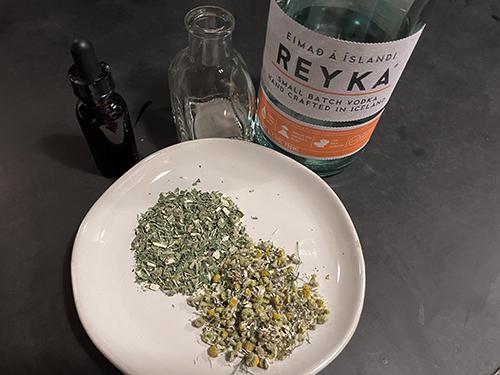 When it comes to the herbs, for this tincture, I recommend using:
When it comes to the herbs, for this tincture, I recommend using:
I wish you would make these recipes printable. Then I could make a whole notebook of valuable wisdom from this site without having to make notes, type and format then print.
Hi Tana,
Thank you for your interest in our articles!
Alongside the social media sharing buttons, there is the “Print” button. You can either print the articles on paper or as pdf files.
Many blessings and good health!
When I bought this book, I was also given a PDF, of The entire book as part of the purchase. When I’m outside, I plan on using the PDF version on my phone or Kindle , My Kindle allows me to highlight it. I have not tried this on my phone yet
If this is your interest, the book is excellent.
Hello, I’ve got to say I love the book and have turned it on to so many Naturalist friends. I have one questions about the tinctures? in the book it gives detail instructions on how to mix them in jars and to wait for days or weeks. I have bought (and some know this machine it’s really popular) The Magic Butter machine.. Are these recipes still the same for this machine? a few of my friends have made some tinctures and they are saying they are coming out great. But before I waste my herbs into expensive alcohol I’d like to know if there are any special tips to mixing and using this butter machine. It makes these tinctures in several hours instead of weeks. Is there a trick to making them a little stronger? like you would leave them in the jar another week? verses the time set for making it in the machine at regular strength? Thank You and Bless you. I’ve actually removed myself from 2 prescription meds by taking some TT mushroom and occasional smoke medley I made. Loving your book.